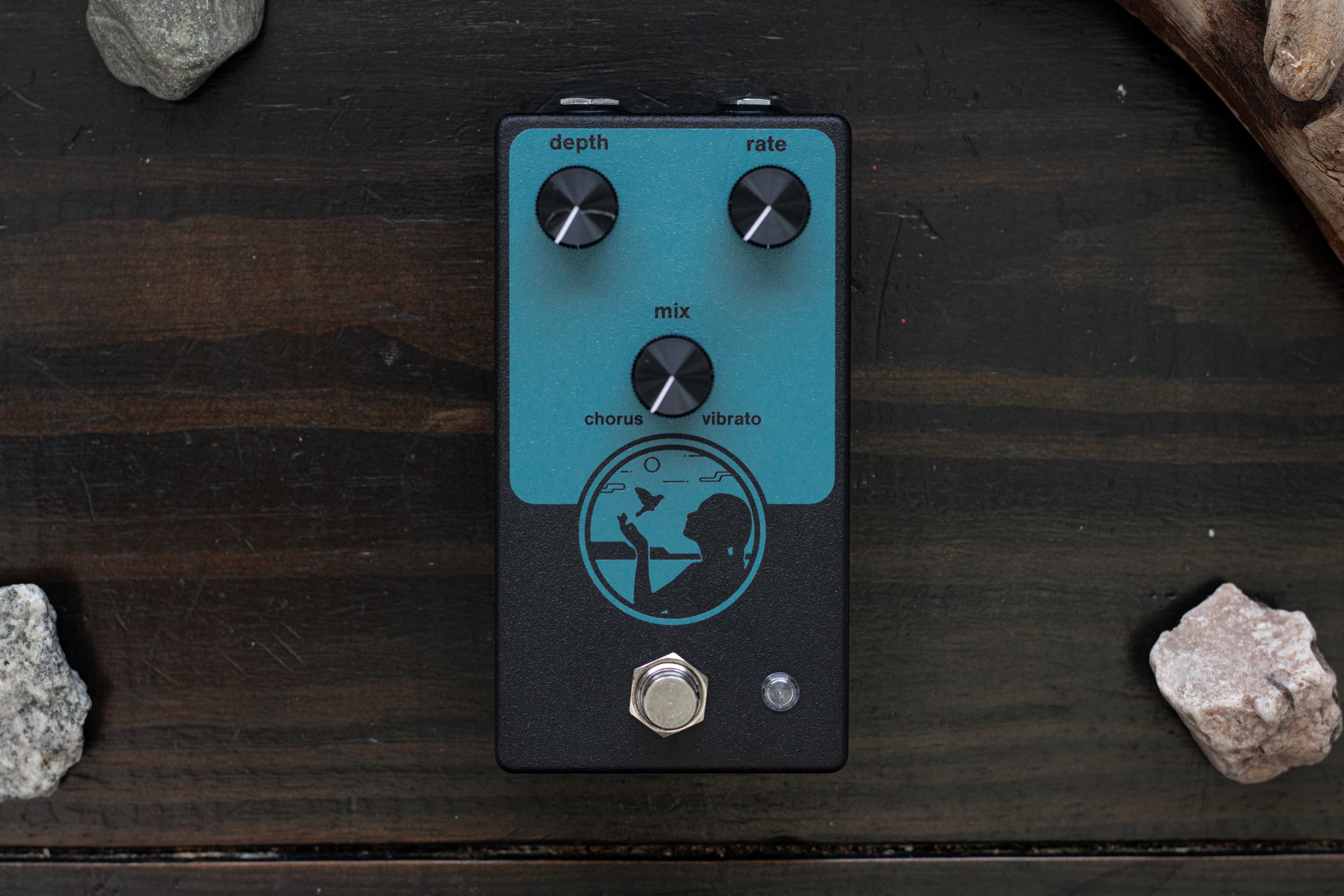Aakii.
Aakii.
Aakii (ah-gee) is a chorus and vibrato pedal designed to deliver warm modulated tones in a gig-friendly format. The streamlined interface includes independent depth, rate, and mix controls for an optimized and effective modulation experience. From a lush and aquatic chorus to a thick and syrupy vibrato, Aakii provides a range of vintage and modern choral voicings.
Aakii and the Oki Series.
Aakii adds another dimension to the story and sound of our Pretty Bird Woman chorus/vibrato and continues our exciting journey into the Oki (oh-key) Series. Oki is the Blackfeet translation meaning hello and is the welcoming front for NativeAudio.
The Oki Series offers a streamlined interface for the musician that might be either dipping their toes into the crazy world of effects, need a gig-friendly yet effective pedal solution, or want a great place to start their NativeAudio journey. Other notable products in the Oki Series are Buffalo Days, Kiaayo, and Makoyii.
A piece on the multi-series.
At NativeAudio, we hope to share our culture through sound and this year we’ve introduced the multi-series to enhance the context behind our stories, allowing for a deeper exploration of the narratives that have influenced our Blackfeet Nation.
The multi-series also provides an opportunity to revisit some classics from our product line and showcase fresh design approaches to our well-known effects that musicians have grown to cherish. You can learn more about the multi-series here.
From Pretty Bird Woman to Aakii.
Let’s talk adjustments that we made going from Pretty Bird Woman to Aakii. In Aakii, we shortened the delay time, swapped mode for a mix control, and removed the presets.
The delay time is slightly shorter for a more responsive chorus/vibrato. In place of mode, we’ve added a mix control to fully blend between chorus and vibrato. Finally, by removing the preset capabilities, we not only direct the musician's focus to one set of modulation parameters but also cultivated a heightened sense towards the musician’s performance.
As a small note, I think it important to also highlight that we didn’t completely shift away from the sounds of Pretty Bird Woman. Aakii still maintains both chorus and vibrato, the optimized depth and rate ranges, and our uniquely filtered delay line that delivers warm modulation.
The Goldilocks of tone.
Think back to a time when you were in a meeting that was too long. I mean like crazy long. You know the one where you’re on the verge of snoozing with your thousand-yard stare, thinking about all the tones you could be cooking up at home or in the studio. Well, what if you could make that meeting shorter, giving you more energy to be responsive? This same concept applies to delay time and your modulated tone.
A shorter delay time will result in a responsive chorus/vibrato and if you’re a player that likes to arpeggiate or strum funky chords, you need something that’s responsive. Now don’t think we’re getting too wild with this shorter delay stuff because if delay time is too short, we’ll be in flanger territory. Aakii, on the other hand, has been finetuned to address an assortment of modulated situations. It’s not too hot (long) and not too cold (short) – it’s the Goldilocks of tone, made perfectly to celebrate all occasions of chorus and vibrato.
Let’s mix things up.
Okay, now is time to get a wild and we’ll request help from our friend, mix. The mix control on the surface seems pretty simple; fully left and you’re swimming in chorus, fully right and you’re wabbling in vibrato, but it’s the in-between where the magic lies.
Say you’re sitting at full vibrato, it’s thick and definitely sick. However, the moment calls for those same vibes but with more sheen on the modulation. That’s when we go to our mix control and dial it back slightly towards chorus. Suddenly, what was our thick vibrato starts to lighten up and gain some sparkle. The same method applies to chorus and like adding flour to water, your tone will begin to thicken as you turn that mix knob towards vibrato.
If you gain anything from this section, it’s that the mix knob expands the modulation capabilities exponentially, making it a huge gamechanger. One thing that I noticed with the Chorus Ensemble from Boss was that there were certain tones you couldn’t get from the CE-2 that you could get from the CE-1. The sounds were mystical, almost bordering the lines of both chorus and vibrato. I tried and tried to get these tones with my previous chorus pedal adventures but with Aakii’s new mix control, my dreams have come a reality.
Bye, bye (presets).
Presets are funny because they have a time and a place. The existence of presets truly depends on if you need to recall specific tones at a moment’s notice. The path we went with Pretty Bird Woman and having four presets on tap was a perfect way to make the complex simple. While other manufactures were figuring out how to fit hundreds of presets into a small box, we wanted to keep things manageable and give you a handful of presets.
Aakii keeps the simple train rolling by dropping the presets and removing the secondary control, mode, that could only be accessed by holding the on(hold) switch and turning depth. We found that layers of complexity begin to develop whenever you add another switch, knob, or hold function. Our goal was to make Aakii gig-friendly and have it be a pedal that provided a collection of amazing sounds with minimal control. That whether you’re a new pedal pusher or a total gear nerd, Aakii’s form factor takes your focus off the pedal and allows you to fully engage in your performance.
You’re in control.
We talked about adjustments that were made going from Aakii to Pretty Bird Woman but let’s discuss the features we did keep. We received overwhelming feedback on the how much people enjoyed Pretty Bird Woman’s depth and rate range. With the ability to go to super slow on the rates and dive really deep in the depth, it’s only natural that we had to keep this party going with Aakii.
Taking the same depth and rate ranges on Pretty Bird Woman’s vibrato mode, we have now extended it into all mix settings on Aakii. It’s no surprise that we spent a ton of hours during development, testing a variety of analog chorus pedals, finding the best operating ranges, and really pushing the limits of what was capable. In the end, Aakii is a modulation machine that’s practical yet built to explore the endless boundaries of creativity.
Getting warm and cozy.
Here’s my biggest take on chorus. We need to stop acting like chorus pedals don’t sound cold and metallic. When did it become a standard to thin out the bass and emphasize the highs? We’ll take a pass on this one. We believe that chorus was truly meant to be expressed in all frequency ranges of the spectrum. You would never throw a birthday party and leave out your best friends, right? So why do this to your chorus tone then?
Let’s get nerdy for a second. In a typical analog design, you’re faced with a challenge to cut the low frequencies in hopes to not drive the delay chip into saturation. The result is a pedal that, in the audio spectrum, looks like a friend with a bad haircut. Too much off the bottom and way too much on the top. How do we achieve a solid chorus tone then? Well, with the digital structure of both Pretty Bird Woman and Aakii, we can tweak specific frequencies and make the audio design totally flexible. You could still achieve a similar filtering capability in an analog design, but it would be a pure chaos, resulting in a design that is component heavy and most likely, more expensive.
Okay, we say all of this about filtering and design but what does this mean for Aakii? Well, it means that Aakii is equipped with the same unique filtering approach as Pretty Bird Woman. We went under the hood, found where the bass was being cut and the highs were being emphasized, and removed all of that nonsense. The result is a modulation pedal that feels like you’re cuddled up next to a fireplace with warm and cozy blanket.
A piece about the extras.
Aakii, along with other pedals in the Oki Series, offers more than surface-level operation. In addition to the comprehensive set of modulation controls and sounds, there’s some extra goodies that make Aakii truly special. These include the smart switching capabilities and a buffered-bypass design. With these additional features, Aakii delivers a complete package designed to elevate your musical experience.
Switching made fun.
Smart switching has become a standard feature across all NativeAudio products. By enhancing the switching capabilities, musicians can now go beyond traditional latch switching. NativeAudio’s smart switching brings a new level of versatility, offering both latch and momentary switching based on how long the switch is held. Latch mode is more traditional where you press the switch quickly and the pedal turns on. While momentary mode is perfect for adding a dash of spice by holding the switch down then releasing the switch when you’re ready to turn the pedal off. Either switching method will get the job done but it’s all about giving you the flexibility to shape your sound.
But is it true bypass?
"Is it true bypass?" A question that feels super aged now. But hey, hardware design has come a long way. Buffered bypass doesn’t have to be some boring and tasteless term designed by engineers only aiming to meet spec. As an electrical engineer, who also loves playing music, I'm here to tell you that buffered bypass is where it's at. Trust me, it's an easy win because the benefits totally outweigh any drawbacks when you've got that buffer design dialed in.
Our buffered bypass won't mess with the highs or lows of your original signal, and it definitely won't give it an unnecessary boost. But here's the real bonus: when you're dealing with a bunch of patch cables or running long instrument cables, the signal stays true to its original sound. So, whether you're jamming with a tangled mess of cables or rocking out on a stage with some serious distance between you and your amp, rest assured that your sound will stay pure and unaltered with our buffered-bypass design.
A quick recap.
Aakii shares a new perspective on our Pretty Bird Woman chorus/vibrato with a streamlined interface and additional features to deliver warm, modulated tones in a gig-friendly format. The new features include an adjusted delay time for a responsive sound, mix control for expanded chorus/vibrato offering, and a new form factor taking your focus off the pedal and shifting it towards your performance.
The story of Aakii.
Before we end, I want to take a moment to share the story of Aakii.
Aakii (ah-gee) is the Blackfeet translation meaning woman. Aakii honors my grandmother who was given the birth name, Pretty Bird Woman, and who embodies the values of our Blackfeet (Amsskaapi Piikuni) people.
We all have a Pretty Bird Woman in our life, and they hold a special place in our hearts. We must remember to treasure them because they are the Northern Star to our life and the guidance when we run astray. They are the foundation to our values, reminding us of who we are and who we want to be.
They are warriors in our lives that will go to war for our wellbeing. They embrace exploration and encourage the pursuit of dreams. So, I encourage you to take this as a reminder to love and cherish those who hold a special place your heart.
The artwork features the silhouette of my sister who was gifted the Pretty Bird Woman name upon birth from my grandmother. A young bird can also be seen taking its first flight, symbolizing growth as my sister continues the legacy of Pretty Bird Woman.
Mike Trombley, Founder
Change for the better.
We're excited to have you on this journey with us. Our mission at NativeAudio is to keep our Blackfeet culture alive while also embracing the creativity in musicians. You play such a huge part in making that happen, so we thank you for getting weird with us. I look forward to you exploring and experiencing the inspiration that comes from the story and sound of Aakii.
Much love.
Let’s make some noise!
Now that we’ve explored the possible, let’s go and create the impossible. Visit here for Aakii.









